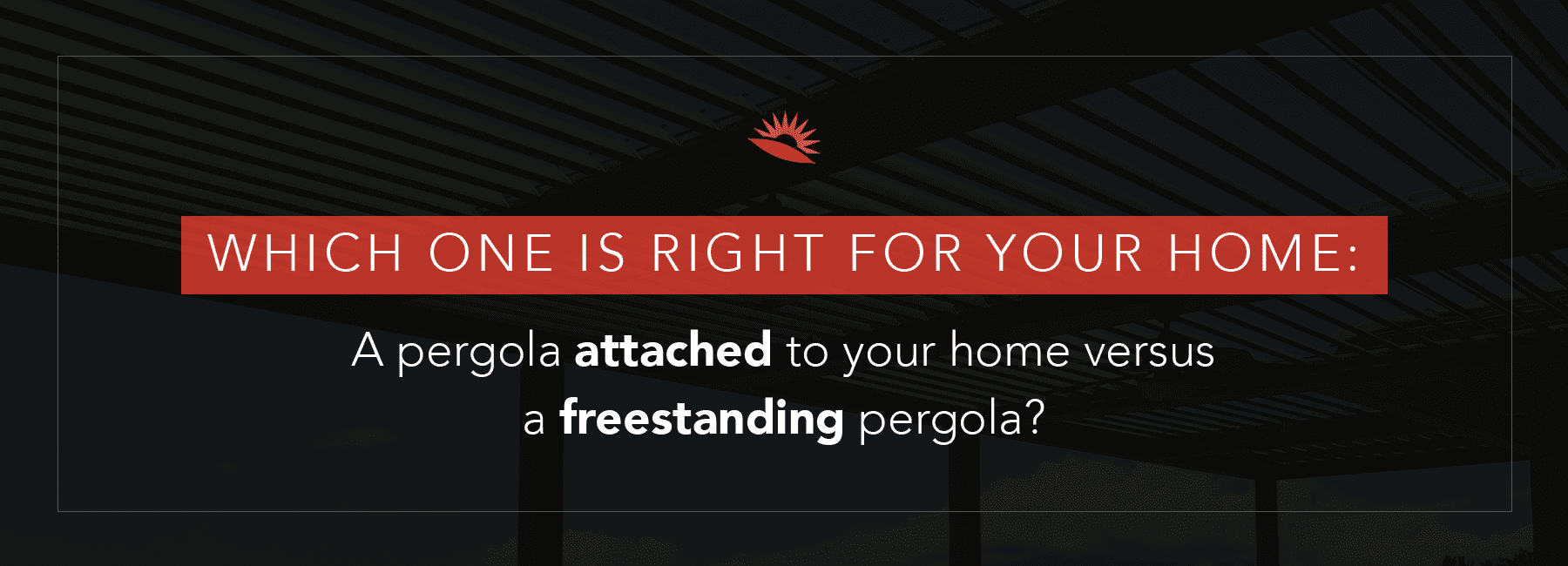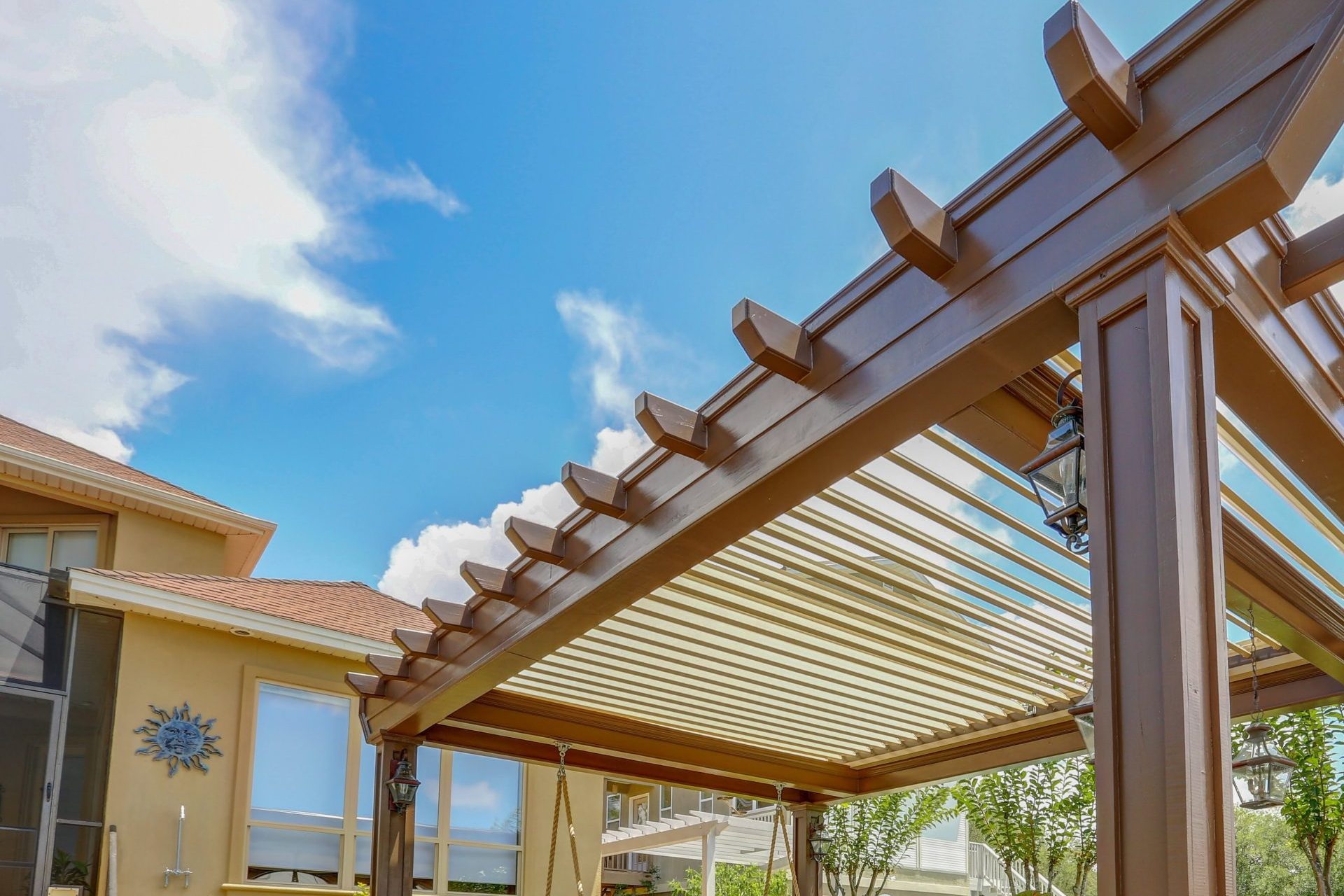
Pergolas have swiftly risen in popularity in recent years, becoming an architectural feature that can be found in many contemporary gardens and patios. These elegant structures not only provide shade and shelter but also boost the visual appeal of outdoor spaces, acting as perfect sanctuaries for relaxation and entertainment.
But when homeowners consider setting up a pergola on their property, there is an important decision that must be made: Should they choose the seamless integration of an attached pergola or the versatile independence of a freestanding one? Let’s explore the topic in more detail.
What Is an Attached Pergola?
An attached pergola is anchored or attached to another structure, most commonly the main house or a building. Because it’s affixed to another structure, it usually has fewer posts than a freestanding pergola. For instance, while a freestanding pergola might have four or more posts, an attached pergola might only have two, with the side attached to the house serving as its main support.
Characteristics of an Attached Pergola
- Integration with the Home – It creates a smooth transition from the interior of the house to the outdoor space, effectively extending the living area.
- Shared Wall – One side of the pergola is typically flush with the exterior wall of the home, often above a doorway or spanning the length of a deck or patio.
- Support – While the attached side provides significant support, additional support can be given through columns or posts on the side opposite the attachment, ensuring stability.
- Purpose – A pergola attached to the house often serves as a shade solution for decks or terraces. It can help protect these areas from direct sunlight, making them more comfortable.
An attached pergola is perfect for homeowners looking to seamlessly blend their indoor and outdoor spaces.
What Is a Freestanding Pergola?
A freestanding pergola is an independent outdoor structure that, unlike a pergola attached to a house, doesn’t rely on the support of an existing building. It stands on its own, usually with four or more posts, creating a shaded area in the chosen location, which can be practically anywhere on the property.
Characteristics of a Freestanding Pergola
- Flexibility in Placement – Being independent, it offers flexibility in positioning and can be located wherever you find it most suitable, whether it’s near a pool, in the middle of a garden, or at a particular vantage point on your property.
- Self-Supporting – Typically, a freestanding pergola will have at least four posts or columns to provide stability. However, the number can vary based on the pergola’s design and size.
- Design Potential – Due to its standalone nature, a freestanding pergola can serve as a focal point in landscaping or garden design. With the right additions, such as climbing plants or decorative lighting, it can become a centerpiece of your outdoor space.
- Versatility – It can be used for a multitude of purposes, such as an outdoor dining area, a relaxation nook, or a space for entertaining guests.
A freestanding pergola is ideal for homeowners looking to create distinct areas in their gardens or yards.
Selecting the Right Kind of Pergola
Choosing the best pergola for your residential property is a decision influenced by a variety of factors, each unique to the homeowner’s usage needs and the characteristics of the property itself. Both attached and freestanding pergolas present valid options, each with its own set of advantages and disadvantages. We’ll list some of these in the space below.
Advantages of Attached Pergolas
- Seamless Integration – Attached pergolas blend seamlessly with your home’s architecture, offering a harmonious look that creates a natural extension of your indoor space.
- Cost-Efficiency – Generally speaking, they are less expensive to construct than freestanding pergolas because they use the wall of an existing structure for support, which can reduce the amount of materials and labor required.
- Space Conservation – By utilizing the side of your home, an attached pergola might save yard or garden space, which is especially beneficial for properties with limited room.
- Enhanced Shelter – When placed against a protective wall, the pergola can provide better shelter against prevailing winds or harsh sun, depending on the home’s orientation.
Disadvantages of Attached Pergolas
- Limited Placement Options – Your choices for positioning are restricted by the structure of the home. The pergola’s location will be determined by where it can be feasibly and safely attached.
- Potential Structural Issues – If not properly installed, the pergola might transfer weight or stress to the home’s structure, leading to potential damage. Proper installation is crucial to prevent such issues.
- Maintenance Challenges – Being attached to the home means that maintenance activities, like repainting or repairs, might require careful attention to ensure both the home and pergola are maintained appropriately without causing damage to either.
- Permitting and Regulations – Some local regulations may have stricter guidelines or requirements for structures attached to homes as compared to freestanding ones. Homeowners might need to check with local authorities before construction.
Advantages of Freestanding Pergolas
- Placement Flexibility – One of the most significant advantages is the ability to place the pergola practically anywhere on your property, providing greater design flexibility in landscaping and outdoor space planning.
- Distinctive Design – A freestanding pergola can serve as a centerpiece or focal point in a garden or backyard, allowing homeowners to create a unique outdoor space separated from the home.
- No Structural Risk to Home – Since it’s not attached to your house, there’s no risk of your pergola causing structural damage to it.
- Versatility – They can be strategically positioned for various purposes, such as over a fire pit, next to a pool, or in a quiet corner of the garden.
Disadvantages of Freestanding Pergolas
- Potentially Higher Costs – Because they require their own full support system, the construction might demand more materials, a stronger foundation, and potentially more labor, which can increase costs.
- Less Immediate Shelter – If a sudden rainstorm or harsh weather hits, a freestanding pergola might not offer as quick an access to shelter compared to a pergola attached to the house.
- Increased Maintenance – Being exposed on all sides might mean more maintenance in terms of cleaning, painting, or repairs, as it faces environmental elements from every direction.
- Land Utilization – A freestanding pergola will consume more land space since it doesn’t utilize any part of the existing structures. This might be a concern for those with limited yard space.
The Equinox Advantage
Equinox Louvered Roof systems are versatile, fitting seamlessly into any design, whether you want an attached or freestanding structure. Our pergolas can cover a wide range of areas. You can have a pergola on the front of the house, in the backyard, or in any other spot where there is adequate space. No matter where it is positioned, your pergola will provide sun, light, and weather control.
Made from high-quality aluminum, Equinox Louvered Roof pergolas have few maintenance requirements, ensuring your pergola will remain as striking and functional as the day it was installed. These pergolas have undergone rigorous testing under Miami-Dade County Hurricane protocols to ensure they stand strong against nature’s elements.
Whether you choose a pergola attached to your house or a freestanding structure, Equinox offers unparalleled advantages in design and function. Enhance your outdoor lifestyle and invest in a structure built to last.
